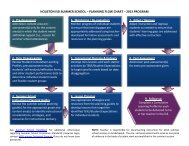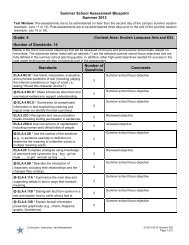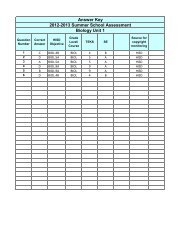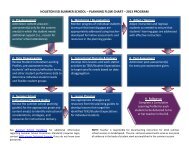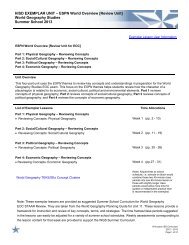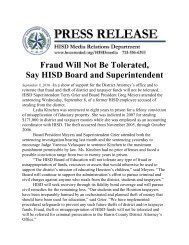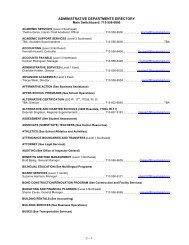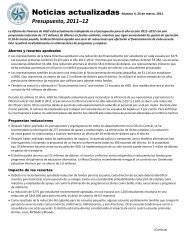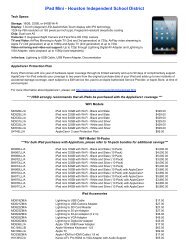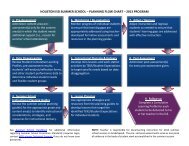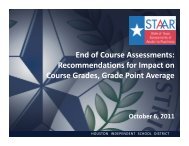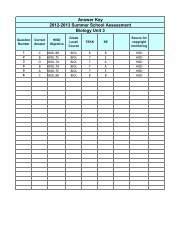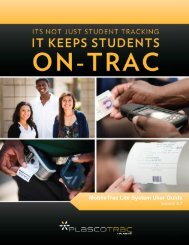SSK Unit 4.2 Planning Guide
SSK Unit 4.2 Planning Guide
SSK Unit 4.2 Planning Guide
- No tags were found...
You also want an ePaper? Increase the reach of your titles
YUMPU automatically turns print PDFs into web optimized ePapers that Google loves.
Instructional ConsiderationsHISD PLANNING GUIDEEnglish Language Arts Grade 7SUMMER SCHOOLReview text features and organizational patterns present in persuasive texts. Focus instruction on utilizing thestructures and organizational aids to locate and organize information (in notes or in graphic representations) for recall,study, and further analysis. See Organizational Patterns for Informational Texts and Literature Grade 7 in Resources.(ELA.7.11A)Explain persuasive techniques (rhetorical devices) found in media and persuasive texts. Emphasize that somepersuasive techniques are stylistic (diction, repetition, allusions, tone, similes, metaphors, imagery, syntax) and othersare content-based (facts, opinions, statistics, testimonials). Reiterate that the purpose of all devices is to influence anaudience. For students who may need more scaffolded instruction, provide students with a condensed list. SeePersuasive Techniques in Resources.Focus on developing knowledge and skills that enable students to deconstruct various forms of persuasive texts. Beginby having students examine media to develop background knowledge of persuasive techniques. Define media. Remindstudents that media includes radio, films, newspapers, periodicals, and television. Use the Media Study- PersuasiveTechniques in Commercials to build background knowledge. See Literature Grade 7 in Resources.Instructional Accommodations for Diverse Learners To support ELLs ability to distinguish between formal and informal language used in media, usestructured conversation activities such as Perspective-Based Activities and Reciprocal Teaching. SeeSeidlitz’s Navigating the ELPS in the English Language Arts and Reading Classroom in Resources.(ELPS C.1g)Remind students that elements found in media have a purpose. To be active recipients, students must become awareof the techniques and devices used in media to influence an audience. Have students focus on specific questions whenreviewing the elements of print media. See Media Element Questions in Instructional Strategies and the Technologyand Inventions- Media website in Resources. (ELA.7.13A, ELA.7.13C)To scaffold student learning, review devices students are familiar with: facts, opinions, and connotations. Review thedifferences between facts and opinions. Use mentor texts to illustrate various examples emphasizing how the authoruses facts and opinions to support his/her position. See Think-Pair-Share- Facts and Opinions in InstructionalStrategies and Best Practices Toolkit in Resources.Have students discuss the following questions through the Think-Pair-Share: How does the author use facts or opinions to explain his/her thinking? What are these facts and opinions supposed to make the reader think? How effective were the facts and opinions in supporting the main topic?Reinforce the idea that though authors and speakers use a variety of means to influence an audience, typically anauthor’s thesis or claim is centered around a specific argument. The structure of the argument supports the thesis andallows the author/speaker to present his/her message and evidence in an organized fashion. Authors also consideropposing viewpoints and refute them by providing counterarguments. See Literature Grade 7, and Resource ManagerGrade 7 <strong>Unit</strong> 8 in Resources. (ELA.7.11A)Types of arguments include: Inductive reasoning- argument by cause-and-effect, argument by analogy, and argument by authority Deductive reasoning- argument by generalizationIn addition to identifying the type of argument an author uses, readers must also be aware of the rhetorical fallacies anauthor uses. Rhetorical fallacies include: ad hominem, circular reasoning, categorical claims, exaggeration,generalization, and stereotyping. See the University of Texas at Austin- Undergraduate Writing Center and RhetoricalFallacies websites, Literature Grade 7, and Resource Manager Grade 7, <strong>Unit</strong> 8 in Resources. (ELA.7.11B) - English Language Proficiency Standards (ELPS) - Literacy Leads the Way Best Practices - Aligned to Upcoming State Readiness Standard- State Process Standard R - State Readiness Standard S - State Supporting Standard© Houston ISD Curriculum2012 – 2013Page 4 of 8




